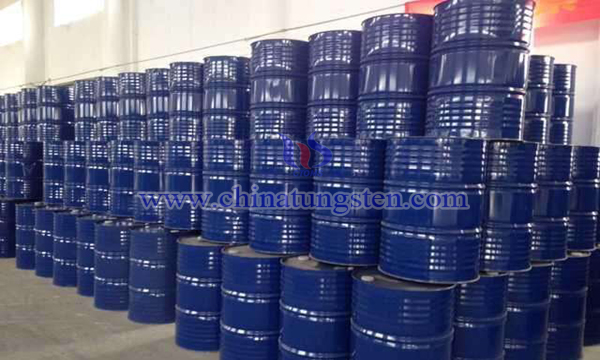Tributyl Citrate Catalyzed by Phosphotungstic Acid Supported on Epoxy Resin
- Details
- Category: Tungsten Information
- Published on Saturday, 27 April 2019 20:51
Due to the defects of concentrated sulfuric acid catalysis, scholars at home and abroad have successively used strong acid cation exchange resin, heteropoly acid, inorganic salts, solid superacid as catalysts to prepare tributyl citrate. Comparing various methods, chemists believe that Heteropoly salts with Keggin structure are the best catalytic scheme. For example, phosphotungstic acid with Keggin structure is an oxygen-containing polyacid bridged by heteroatom P and coordination atom W through oxygen atom coordination unit. It has both the function of acid catalysis and oxidation catalysis. It is a protonic acid with uniform strength and high catalytic activity.

Epoxy resin is an organic macromolecule compound containing two or more epoxy groups. Because of the active epoxy groups in the molecular structure, they can cross-link with various curing agents to form insoluble, non-melting polymer with three-way network structure. The cured epoxy resin system has excellent mechanical properties and chemical stability, showing outstanding alkali resistance, acid resistance and solvent resistance.
Catalyst preparation with 5% phosphotungstic acid loading: 0.5g phosphotungstic acid (analytical purity) was weighed and dissolved in 1.5ml distilled water, stirred to dissolve it adequately. 10g ground epoxy resin 604 powder (25-30 mesh) was weighed and placed in 100ml beaker. The phosphotungstic acid solution was transferred to beaker to immerse epoxy resin powder exactly. The powder was stirred by magnetic force for 3h at room temperature (25 ℃), and then mixed evenly. The mixture at room temperature (25 DEG C), static 8h makes water naturally dry, dry to 80 DEG C oven overnight (12 hours), get the phosphotungstic acid loading was 5% (PW12 and carrier quality ratio) supported catalyst.
The Supported Phosphotungstic acid catalyst can be used as catalyst for preparing tributyl citrate. In a 100 ml flask with water separator, electric agitator and thermometer, the reaction of citric acid and n-butanol is massaged at 1:3, massaged at 1:5, excessive n-butanol is used as water carrier, 10.51 g of citric acid is weighed, 22.88 ml of n-butanol is added to the flask, and stirred at low temperature. When citric acid dissolves completely, 2.02g catalyst is added, and the amount of catalyst is 2.5%. Then the temperature rises to 120 ℃ and refluxes at constant temperature for 3 hours. The water generated during the reaction is separated in time through the water splitter. After the reaction is finished, 5% sodium carbonate solution is neutralized, and then the redundant n-butanol and water are removed by vacuum distillation to obtain a pale yellow transparent product, tributyl citrate. The conversion of citric acid was 95.26%, and the selectivity of tributyl citrate was 93.43%.
- Tungsten Oxide Manufacturer & Supplier, Chinatungsten Online: www.tungsten-oxide.com
- Tungsten News & Prices of China Tungsten Industry Association: www.ctia.com.cn
- Molybdenum News & Price: news.molybdenum.com.cn
- Tel.: 86 592 5129696; Fax: 86 592 5129797; Email: sales@chinatungsten.com



 sales@chinatungsten.com
sales@chinatungsten.com